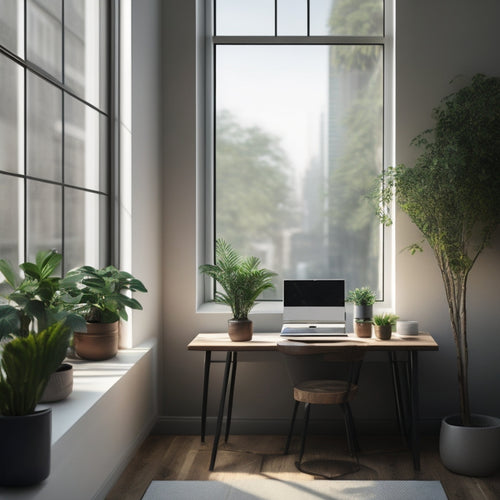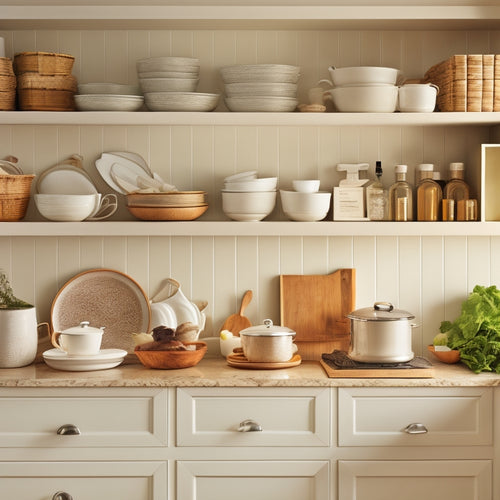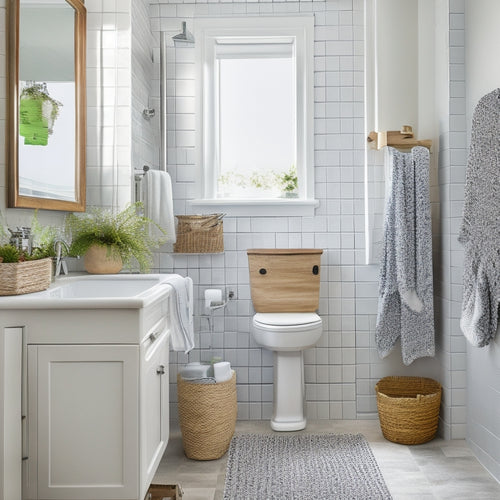
Simplify Your Space: Senior-Friendly Home Organization Systems
Share
You want to simplify your space and make it more senior-friendly. Start by incorporating mobility aids like walkers or canes into your storage solutions. Choose furniture with adjustable heights and ergonomic design to prioritize comfort and accessibility. Create a clutter-free living space with easy-to-grasp handles and smooth-gliding drawers. Next, focus on easy access shelving systems, simplified closet organization, and adaptable bathroom storage. By implementing these senior-friendly home organization systems, you'll maintain independence and comfort in your daily routines. Now, discover more ways to optimize your space and simplify your life.
Key Takeaways
• Create a senior-friendly home by incorporating mobility aids, adjustable heights, and ergonomic design in storage solutions and furniture.
• Implement easy access shelving systems with customizable storage, accessible design, and smooth-gliding drawers for independence and comfort.
• Simplify closet organization with color-coding, space-saving solutions, and seasonal rotation to quickly locate items and eliminate frustration.
• Declutter living spaces by adopting a minimalist approach, using organizational hacks, and investing in efficient storage solutions for a safe environment.
• Adapt bathroom storage with adjustable shelves, sliding drawers, and grab bars to maintain a safe and accessible bathroom environment for aging needs.
Senior-Friendly Storage Solutions
As you start organizing your home, senior-friendly storage solutions become essential to create a clutter-free and accessible living space that accommodates your changing needs. You'll want to focus on functional furniture that caters to your mobility and comfort.
Consider incorporating mobility aids, such as walkers or canes, into your storage design. This will make sure that you can easily move around your space without obstacles.
Look for furniture with adjustable heights and ergonomic design to reduce strain on your body. For example, a storage ottoman with an adjustable height can provide a comfortable seating option while keeping essentials within reach.
When choosing storage solutions, prioritize those with easy-to-grasp handles and smooth-gliding drawers to minimize effort. By incorporating these senior-friendly features, you'll create a space that supports your independence and comfort.
With thoughtful storage solutions, you'll be able to maintain your independence and enjoy your home without feeling overwhelmed or frustrated.
Easy Access Shelving Systems
You'll want to install shelving systems that bring frequently used items within easy reach, allowing you to access what you need without straining or struggling.
Adjustable shelving is a great option, as it can be customized to fit your specific needs and preferences. This type of shelving allows you to adjust the height and spacing of the shelves to accommodate items of varying sizes, making it easy to store and retrieve what you need.
When designing your shelving system, prioritize accessible design and functional organization. This means placing frequently used items at waist level or below, reducing the need for bending or stretching.
You can also incorporate customized storage solutions, such as baskets or bins, to keep similar items together and make them easy to find. By doing so, you'll create a shelving system that's both functional and easy to use, allowing you to maintain your independence and confidence in your daily routine.
Simplified Closet Organization
By implementing a simplified closet organization system, you can quickly locate what you need and get dressed with ease, eliminating the frustration that often comes with digging through cluttered closets.
Here are some practical tips to get you started:
-
Color code your closet: Use color-coded hangers to categorize your clothes by type, season, or occasion. This visual system helps you identify what you need at a glance.
-
Utilize space-saving solutions: Maximize your closet space with shelves, bins, and double rods. This will help keep your belongings organized and prevent clutter from building up.
-
Implement seasonal rotation: Store out-of-season clothes in labeled bins or containers to free up space and reduce decision fatigue.
- Optimize shoe storage: Use a shoe rack or over-the-door organizer to keep your shoes organized, visible, and easy to access.
Decluttering for Seniors
Now that your closet is organized, it's time to tackle the rest of your living space, where clutter can be overwhelming and even hazardous for seniors. You've made a great start, but it's vital to declutter your entire home to ensure a safe and comfortable living environment.
To get started, try implementing downsizing strategies like letting go of items you no longer need or use. This will help you adopt a more minimalist living approach, making it easier to maintain your space.
Next, use organizational hacks like categorizing and grouping similar items together, and assigning a designated spot for each item. This will help you stay organized and make the most of your space.
Consider investing in efficient storage solutions like shelves, bins, and baskets to keep items out of sight and off the floor. Remember, the goal is to create a clutter-free space that's easy to navigate and enjoy.
Adaptable Bathroom Storage
When designing your senior-friendly bathroom, you'll want to prioritize adaptable storage solutions that make your daily routine easier.
That's why it's crucial to prioritize easy access shelves that allow you to reach your toiletries without straining or bending.
Easy Access Shelves
You can install easy access shelves in your bathroom to create adaptable storage that accommodates your changing needs as you age. This is especially important in the bathroom, where storage is often limited and hard to reach. With easy access shelves, you can create a more senior-friendly space that makes daily routines easier and less straining.
Here are some features to contemplate when installing easy access shelves in your bathroom:
-
Adjustable height: Shelves that can be adjusted to different heights allow you to customize your storage to fit your needs, whether you're standing or sitting.
-
Sliding drawers: Sliding drawers make it easy to access items without having to bend or stretch, reducing strain on your back and joints.
-
Open shelving: Open shelving allows you to easily see and access the items you need, reducing clutter and making it easier to find what you're looking for.
- Grab bars: Installing grab bars near your easy access shelves provides additional support and stability, making it easier to navigate your bathroom.
Clear Floor Paths
Clear Floor Paths
By keeping floor paths clear of clutter and tripping hazards, you create a safer and more accessible bathroom environment that accommodates your changing needs as you age. Clear walkways are essential for safety first, ensuring you can move around comfortably without worrying about tripping or falling.
To achieve pathway organization, consider the following tips:
| Tip | Description | Benefits |
|---|---|---|
| Remove clutter | Pick up items like toiletries, towels, and trash cans | Reduces tripping hazards, creates clear aisles |
| Install grab bars | Place them strategically near the shower, toilet, and sink | Provides support and balance, reduces fall risk |
| Secure cords | Use cord organizers or tape to keep cords out of the way | Reduces tripping hazards, keeps floors clear |
Kitchen Organization Essentials
Optimize your kitchen's functionality by incorporating these essential organization systems that cater specifically to seniors' needs. A well-organized kitchen can greatly impact your daily life, making meal preparation and cooking more efficient and enjoyable.
Here are four must-have kitchen organization essentials to get you started:
-
Pantry Organization System: Maximize your pantry's storage capacity with adjustable shelves, baskets, and bins to keep food and cooking supplies within easy reach.
-
Utensil Storage Containers: Designate a specific spot for utensils, such as a utensil organizer or a drawer divider, to prevent clutter and make them easily accessible.
-
Countertop Clutter-Control Measures: Implement a 'landing strip' near the sink or stove to corral frequently used items, and consider a countertop organizer for spices, oils, or condiments.
- Cabinet Organization Solutions: Install pull-out shelves, baskets, or Lazy Susans to make the most of your cabinet space and reduce straining or bending to access items.
Labeling and Signage Tips
When it comes to labeling and signage in your senior-friendly home organization system, you'll want to make sure it's easy to navigate.
You'll achieve this by clearly marking storage areas, using easy-to-read font sizes, and maintaining a consistent labeling style throughout your home.
Clearly Mark Storage Areas
You can easily identify what's stored where by labeling each storage area with its contents, making it simple to find what you need. This is especially important for seniors who may have difficulty remembering where items are stored. Clearly marking storage areas is a key aspect of storage organization and can save you time and frustration in the long run.
Here are some labeling techniques to keep in mind:
-
Use clear and concise language: Avoid using abbreviations or jargon that might be confusing.
-
Choose the right label size: Make sure the label is large enough to read easily, but not so large that it's overwhelming.
-
Select a consistent font style: Stick to a single font style throughout your labeling system to create a sense of cohesion.
- Color-code your labels: Use different colors to categorize similar items, such as using blue for cleaning supplies and green for kitchen utensils.
Easy-to-Read Font Sizes
Select font sizes that are at least 18 points or 1/4 inch tall to ensure labels are easily readable from a distance, especially for seniors with visual impairments. This large print will help confirm that you and your loved ones can quickly identify what's inside containers or on shelves.
When choosing a font, opt for one with high font contrast, such as black text on a white background or vice versa. This will make the text stand out and reduce eye strain. Avoid using fancy or decorative fonts, as they can be challenging to read, especially for seniors with declining vision. Instead, stick to simple, sans-serif fonts like Arial, Helvetica, or Calibri.
Consistent Labeling Style
Establishing a consistent labeling style throughout your home organization system guarantees that everyone, including seniors, can quickly understand and navigate the system with ease. This is especially important for seniors who may struggle with cognitive or visual impairments. A consistent labeling style helps reduce confusion and makes it easier for them to find what they need.
Here are some tips to create a consistent labeling style:
-
Choose a font:
Select a clear, easy-to-read font and use it throughout your labeling system. -
Use color coded organization:
Assign specific colors to different categories or rooms to create a visual hierarchy. -
Implement functional labeling techniques:
Use labels that describe the contents or purpose of a shelf, cabinet, or bin.
-
Be concise:
Keep labels short and to the point to avoid overwhelming seniors with too much information.
Senior-Centric Product Recommendations
Five senior-friendly product categories can simplify daily living and enhance independence for older adults. You'll find that incorporating these products into your home can make a significant difference in your daily routine.
First, consider ergonomic furniture that's designed to promote comfort and reduce strain. Look for chairs with extra lumbar support, beds with adjustable heights, and tables with built-in storage. These features can help you conserve energy and move around with ease.
Additionally, invest in accessible technology, such as voice-controlled devices, large-button remotes, and high-contrast displays. These tools can help you stay connected and entertained without straining your eyes or fingers.
When it comes to decor, opt for senior-friendly designs that prioritize functionality. Choose furniture with clean lines, minimal clutter, and ample lighting. This will help reduce visual confusion and make it easier to navigate your space.
Maintaining Your Organized Space
You'll need to set aside time each week to maintain your newly organized space and guarantee it continues to support your independence and comfort. This might seem challenging, but with a few simple habits, you'll be able to keep your space organized and clutter-free.
Here are some tips to help you maintain your organized space:
-
Schedule regular tidying sessions: Set aside 15-30 minutes each day or an hour on the weekend to tidy up and put away items that are out of place.
-
Practice good time management: Make organization a priority by incorporating it into your daily routine, just like brushing your teeth or taking a shower.
-
Stay spatially aware: Pay attention to the layout of your space and make adjustments as needed to ensure everything has a designated place.
- Create a 'one in, one out' rule: Whenever you bring a new item into your space, discard an old one to maintain a balanced level of possessions.
Frequently Asked Questions
How Do I Get My Family Members to Respect My Organized Space?
You're frustrated when family members disrupt your organized space, like Sarah, whose grandkids would scatter toys everywhere. Set clear boundaries and communicate your needs; consistently reinforce them, and be open to compromise – it's key to maintaining your sanctuary.
Can a Professional Organizer Help Me With Senior-Friendly Home Organization?
You can hire a professional organizer who specializes in senior-friendly home organization to help you create a tailored system. They'll provide benefits like increased safety and accessibility, and services including customized solutions, decluttering, and organizing techniques that cater to your needs.
Are There Any Grants or Funding for Senior Home Organization Projects?
You're solving a puzzle, trying to find the right pieces to fund your senior home organization project. You'll find funding opportunities through grant applications, offering financial assistance for home improvements, helping you create a safe and comfortable living space.
What Are Some Eco-Friendly Options for Senior Home Organization Systems?
You'll find eco-friendly options for senior home organization systems by opting for reusable storage bins, recycled materials, and sustainable furniture, which complement senior-friendly decluttering methods that prioritize accessibility and simplicity.
How Often Should I Reassess and Adjust My Senior-Friendly Home Organization Systems?
Did you know that 71% of seniors prefer to age in place? You should reassess and adjust your home organization systems every 6-12 months, scheduling regular evaluations and maintenance updates to guarantee they continue to meet your evolving needs.
Related Posts
-

Transform Your Space: 5 Online Courses to Help
Ready to transform your space from cluttered to calm? Start with mastering home organization fundamentals, like declu...
-

Why Kitchen Cabinet Organization Matters Most
You're likely losing more than just time and ingredients when you can't find what you need in your kitchen cabinets -...
-

Bathroom Storage Hacks for Small Spaces Revealed
You're about to discover the ultimate bathroom storage hacks for your small space! Start by maximizing your vertical ...


